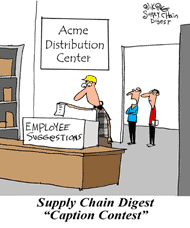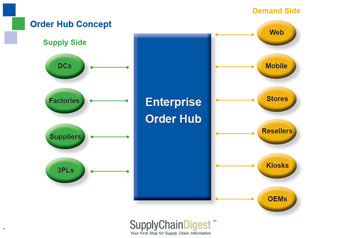 |
August 6, 2015 - Supply Chain Flagship Newsletter |
 |
| FEATURED SPONSOR: ZEBRA |
||
 |
||
Download Our Complimentary White Paper Now To Learn the Ten Steps to Finding the Right Mobile Device |
 |
|
|||||||||||||||||||||||||||||||||||||||||||||||||||||||||||||||||||||||||||||||||||||||||||||
As evidence of that, I summarized some data I had collected from members of JDA Software's Demand Optimization Council (DOC), made up of some of its best retail, consumer goods and wholesale customers during meeting this Spring, which I get to attend as a contributing guest. I got survey responses from a little over 20 members, not a big number for sure, but as I noted two weeks ago, I am not sure the results would have been that different if I had surveyed 200 companies. 36% said they had a formal supply chain strategy (including one that had just gone through the effort for the first time), another 36% that did not have a formal strategy, and 27% which answered "Sort Of," a response choice I included correctly suspecting many would place themselves in that category. Compare that to results from a similar survey Paul Dittmann of the University of Tennessee conducted in 2013 that found just 18% of the members of his Supply Chain Forum had a formal written supply chain strategy. So, can we say just 18-36% of companies have a strategy exercise and document? I think that is quite likely, a probably more likely in the lower side of that range. And that is quite interesting, is it not?
The survey responses were collected before the JDA DOC meeting. During my short presentation on the survey results, I ask all the attendees - almost all director level and above - to write down their definition of what a supply chain strategy is or should be. To say the responses were highly varied is a great understatement. Below is a selection of those definitions attendees offered: I have quite a few more, but you get the idea. I would say this: each one of these definitions has its merits, yet no two (including the other ones I didn't post here) are all that similar.
"Supply Chain Strategy is really operations strategy," Tyndall says. "A company should view its supply chains as the key component of its operations. While its business strategy is about products and markets, and why customers will buy its products, its operations strategy is about the capabilities necessary to fulfill those customer value propositions. So, procurement, production, distribution, transportation, and inventories all need the capabilities to deliver on the business promises."
Dadmun also believes that today, a plan for improving visibility needs to be a core aspect of a supply chain strategy. "The best supply chain is one that is responsive," he says, and visibility is essential to achieve that responsiveness. He believes that for many companies today the overall a strategy needs to articulate a vision and plan for leveraging "Internet of Things" technology and capabilities, and - in an area where he has focused his thinking for many years - also include an overall plan for supply chain business intelligence and predictive analytics. So that's all pretty interesting too, especially in that Dadmun is saying there are likely to be a set of newer technologies/capabilities at any given time that need to be addressed in a supply chain strategy document. There's more, but I am going to leave it here for you to ponder. I will be back soon with more, including at last my own definition. Would love your thoughts.
|
||||||||||||||||||||||||||||||||||||||||||||||||||||||||||||||||||||||||||||||||||||||||||||||
|
||||||||||||||||||||||||||||||||||||||||||||||||||||||||||||||||||||||||||||||||||||||||||||||
|
||||||||||||||||||||||||||||||||||||||||||||||||||||||||||||||||||||||||||||||||||||||||||||||
|
|
|
YOUR FEEDBACK
More emails this week on our story on the small retail chain Peltz Shoes publicly abandoning its item-level RFID program, some through our partnership with the good folks over at RetailWire. You will find a selection below.
Feedback on Peltz Shoes RFID Failure:
The Peltz experience clearly shows the need to use a knowledgeable integrator and to do a lot of work up front to understand all of the possible scenarios and address each. |
||
I second Nikki Baird's observation regarding the age of the RFID technology Peltz is apparently using. Based on this article and 2010 articles about the Peltz solution, it sounds like they are using 2009 technology. Much has changed. Tag performance and field reliability is substantially better now that it was in 2009, and reader options have evolved as well. |
||
Didn't we have the same discussion 20 years ago trying to get manufacturers to put anti-theft tags in the packaging? An idea not nearly as simple as it sounds, like whose tag? It remains to be seen if this chain's experience is unique or common, since retailers generally don't put press releases out about program failures! And we don't go to conferences and trade shows and visit booths announcing what doesn't work. J. Kent Smith
|
||
It is amazing how hard it can be for a retailer to get its perpetual inventory to be right at store level. RFID or not, it's just addition and subtraction. Even more critical today with needing an accurate picture of availability to promise for online, and store inventory needing to be exposed to the web shopper who wants to click and collect. Peter J. Charness |
SUPPLY CHAIN TRIVIA ANSWER
Q: What were the top five countries in terms of the value of exports of goods/merchandise in 2014?
A: (1) China; (2) USA; (3) Germany; (4) Japan; (5) South Korea. Canada was number 11 and Mexico, number 13.
| © SupplyChainDigest™ 2003-2015. All Rights Reserved. SupplyChainDigest PO Box 714 Springboro, Ohio 45066 |
POWERED BY: XDIMENSION
|








 OK, there is a lot there to consider. I then turned to Tom Dadmun, recently retired head of supply chain for network gear maker Adtran, who told me "I could write for hours on this topic."
OK, there is a lot there to consider. I then turned to Tom Dadmun, recently retired head of supply chain for network gear maker Adtran, who told me "I could write for hours on this topic."

